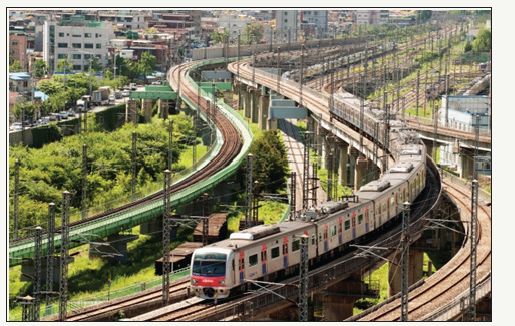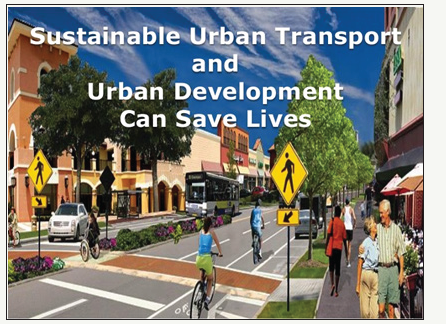- Submissions

Full Text
Environmental Analysis & Ecology Studies
Sustainable Urban Transport- An Emerging Need of Today
Akshey Bhargava1* and Ar Disha Bhatt2
1 Department of Civil Engineering, Global Institute of Engineering and Technology, India
2Parul Institute of Architecture and Planning, India
*Corresponding author:Akshey Bhargava, Department of Civil Engineering, Global Institute of Engineering and Technology, India
Submission: May 14, 2018; Published: May 31, 2018

ISSN 2578-0336 Volume2 Issue5
Abstract
Urban areas or cities should orient towards nature in as much as that the urban ecological environment should be considered as an asset by integrating environmental issues into the process of urban planning and administration. In the present context, sustainable urban transport plays an important role in urban planning and development by providing access for people to education, trade, employment, recreation, health care and other services. But in most of the cities, urban transportation systems is not compatible to ideal situation resulting into traffic congestion, increased air and noise pollution, health effect, create significant impact on local and national GDP among others. An effort has therefore been made by the authors of the present paper to present in brief the planning and development of sustainable urban transport along with its importance.
keywordsUrban planning; sustainability; Environment; Urban transport; Air pollution
Introduction
With rapid urbanization and economic growth, transport sector is significantly increasing in cities in developing countries in as much as that in Asian region, the number of motor vehicles per one thousand people has more than tripled in the past 30 years. Countries where public transport is inadequate or poor, owning of private car or a motorized two-wheeler is becoming a regular feature whereas many cities in developed countries are now trying to focus on re-allocating road space for public transport and nonmotorized transport. Accessible and affordable public transport along with safe infrastructure for non-motorized transport in the form of cycling and walking are lacking in most cities of developing country resulting into significant increase of private vehicles which dominates the roads. As a consequence to such ignorance and approach the transportation sector is responsible for air pollution, noise, greenhouse gas emissions, and road accidents [1]. It is projected that India’s urban population would grow to about 473 million in 2021 and 820 million by 2051, as against only 285 million in 2001 which tends show that the number of vehicles in cities would be in alarming proportion [2].
Sustainable urban transport
In the light of growing and alarming problems on account of present urban transport policies and approach, there is a need to consider following parameters to be infused into the process of integrated urban planning [3]. Encouraging integrated land use and transport planning. Bringing about a more equitable allocation of road space with people, rather than vehicles, as its main focus. Encouraging greater use of public transport and non-motorized modes. Enabling the establishment of quality focused multi-modal public transport systems that are well integrated. Expanding on the meaning of Sustainability, we can view an urban transportation framework as practical in the event that it adds to general monetary development and additional social value, without corrupting the common habitat. There are a few patterns that point to a solid development of urban cargo transport far and wide, for example, the general development of the economy and the lofty development of internet business. The issue is that urban cargo movement in numerous occurrences prompt direct effects on the earth, society and economy. A few effects, obviously, are more extreme and critical than others. The effects, for example, air and commotion contamination, car crashes, blockage and the outflows of ozone harming substances, prompt unsustainable results, for example, environmental change, weakness and security results, delays and, in the long run, unacceptable urban communities. A typical picture of sustainable urban transport is shown in (Figure 1).
We can frequently get the feeling that cargo action are just “terrible”, however that isn’t the situation. The cargo framework holds, above all else, an utilitarian part, which is to encourage the development of cargo, a capacity fundamental to the economy and living of the urban inhabitants. Henceforth, any arrangement went for lessening the negative effects of urban cargo should take mind that the administration nature of the cargo framework isn’t excessively decreased either [4]. An adjusted view will in any event have four angles considered:
A. Transportation quality
B. General state of urban transportation framework
C. Natural concerns and effects
D. Social concerns
The urban transportation framework is a very complex approach. Seeing how the action can influence our urban areas, both now and in the long haul, is an essential initial step to knowing how best to enhance it. Sustainable urban transport if scientifically and seriously planned and implemented can saves human lives as symbolically depicted in (Figure 2).
Figure 1:Showing typical sustainable urban transport.

Figure 2:Showing sustainable urban transport and urban development

Conclusion
the overall urban planning and needs to be integrated with urban development. Presently such an important component is not adequately addressed leading to increased air pollution, noise pollution, heat island, energy consumption and many more problems. It has therefore become essential to develop and validated an integrated sustainable urban transport model for the urban planners to actively incorporate in the overall urban planning along with its implementation. Moreover, continuous field research needs to be encouraged and taken up to develop compatible urban transport model having environmental and sustainability parameters.
References
- Yang Jiemian, Yu Hongyuan, Mohanty CR, Carlos Felipe Pardo, with valuable input and contributions.
- McCann B, Rynne S (2010) Complete streets: best policy and implementation practices. American Planning Association, USA.
- Buis J (2009b) A new Paradigm for Urban Transport Planning: cycling inclusive planning at the pre-event training workshop on nonmotorized transport in urban areas, 4th regional est forum in Seoul, Republic of Korea, South Korea.
- DelftX Courses.edx.org/courses/course-v1
© 2018Akshey Bhargava. This is an open access article distributed under the terms of the Creative Commons Attribution License , which permits unrestricted use, distribution, and build upon your work non-commercially.
 a Creative Commons Attribution 4.0 International License. Based on a work at www.crimsonpublishers.com.
Best viewed in
a Creative Commons Attribution 4.0 International License. Based on a work at www.crimsonpublishers.com.
Best viewed in 







.jpg)






























 Editorial Board Registrations
Editorial Board Registrations Submit your Article
Submit your Article Refer a Friend
Refer a Friend Advertise With Us
Advertise With Us
.jpg)






.jpg)













.bmp)
.jpg)
.png)
.jpg)














.png)

.png)



.png)






